Share
Here’s what we’ll cover in this post (Outline)
Chapter 1:
- Introduction to a minimum viable task
- The Old Way of Skill Testing vs The Best New Way (MVT)
- The Problem with Long, Outdated Skill Tests
Chapter 2:
- Why do you need to assign a minimum viable task?
- The characteristics of a Minimum viable task
Chapter 3:
- How to incorporate a minimum viable task into your hiring process
- How to practically administer a minimum Viable Task using Workscreen
- But how do you skill test for non-remote roles?
- Why Administer a Minimum Viable Task Through WorkScreen?
Chapter 4:
- Tips Useful Tips You Should Not Overlook
- How the MVT (Minimum Viable Task or short skill test) concept applies in the real world
- Final Thoughts
Chapter 1
Introduction to the Minimum Viable Task
A Minimum Viable Task (MVT) is a short skill test designed to mirror real job responsibilities—but in a way that’s efficient, fair, and less intimidating for candidates. Think of it as a mini version of a traditional/normal/long skill-test: It typically takes just 1–2 hours to complete, yet it’s enough to reveal whether a candidate has the ability to do the job.
An MVT strikes the right balance—it’s not overly simple or too complicated. Its main purpose is to help you evaluate a candidate’s practical skills without wasting time or driving away top talent. Despite its short length, a well-crafted MVT can help you assess key traits such as:
- Work ethic
- Communication skills
- Problem-solving ability
- Reliability
- Time management
- Accountability
- Attention to detail
To make the difference clear, let’s compare the old way of skill testing (Traditional skill test) with the best new way (Minimum Viable Task)
The Old Way of Skill Testing vs The Best New Way (MVT)
The Old Way
Assume you are looking for a customer service representative for your organization. A traditional long skill-test looks something like this
“As part of your application for the Customer Service Representative role at Acme Solutions, you are required to complete a 5-part assessment within 8 hours. This includes writing a 1,000–1,500 word industry report with external research, recording five separate 2–3 minute role-play videos simulating customer service scenarios, drafting three 200-word professional email responses to different customer complaints, analyzing a large Excel dataset of 1,500 rows to identify trends and create a visual dashboard, and writing a 500-word process improvement proposal with a proposed timeline. This test is expected to take 8–12 hours.”
Why is this skill test bad?
Because it demands an unrealistic time commitment and burdens candidates with excessive and unclear tasks. Such a skill test will drive away great candidates.
The Best New Way of Skill Testing: (Minimum Viable Task)
We will use the same example as above to show what a good short skill test to assign to a candidate looks like.
You’re applying for a Customer Service Representative role at a fictional company called Acme Solutions. Your task is to respond to a customer email complaint: Jane Lewis was double-billed this month and is threatening to cancel her subscription. Draft a professional, empathetic email (150–200 words) that apologizes, explains how you’ll resolve the issue, and encourages the customer to stay. Submit your response in a Word or PDF document within 48 hours.
Why is this good?
- It focuses on one clear task: Resolving a real-world customer complaint. It’s concise, relevant, and manageable, allowing candidates to demonstrate their skills without being overwhelmed.
The Problem with Long, Outdated Skill Tests
While MVTs offer a smarter alternative, many companies are still stuck in the old way—relying on bloated, outdated skill tests that frustrate candidates and cost you great talent.
If you’re a recruiter, hiring manager, or company founder, and you’ve been asking candidates to take part in such lengthy skill tests, this post is for you. Candidates are voicing their frustration loudly. They’re overwhelmed, burned out, and tired of investing hours into tests that feel excessive and, in many cases, irrelevant.
To drive the point home, here’s a firsthand account from a candidate who shares just how tedious and frustrating these skill tests can be and why you should avoid assigning them.
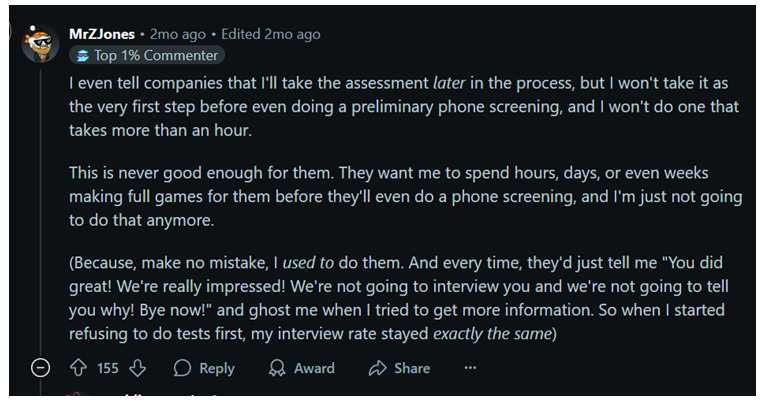
From this candidate’s account, it’s clear how damaging long, drawn-out skill tests can be. These experiences don’t just frustrate candidates—they actively deter top talent from applying to your jobs and damage your company’s reputation.
So, what should you do instead? Should you stop testing candidates altogether? Absolutely not. Skill tests are crucial—they help you make smarter hiring decisions. The real solution? It’s time to move beyond outdated methods and adopt a more effective approach to skill testing: Testing candidates using the Minimum Viable Task (MVT).
Chapter 2
Why do you need to assign a minimum viable task?
- Uncover actual skills
A Minimum Viable Task (MVT) reveals the practical skills a candidate brings to the table. It’s a simple, targeted way to see how they handle the core responsibilities of the role, not just how they talk about it.
An MVT is the most accurate predictor of on-the-job success. It helps you hire with confidence by distinguishing high performers from low performers. Think of it this way: If someone can’t complete a small task before they’re hired, why would you expect them to perform well once they’re on the job? By giving candidates a Minimum Viable Task, you uncover real skills, without overwhelming them with long tedious skill tests.
- Hire beyond resumes, interviews, or years of experience.
Let’s face it: resumes and interviews often fail to reveal a candidate’s true skills. In today’s AI-driven world, you simply can’t rely on them alone. Almost everything can be polished—or outright faked—using AI.
Nowadays, resumes are crafted using tools like Resume.io and Kickresume, perfectly tailored to match your job description. Cover letters are written in seconds with ChatGPT. Candidates are even using real-time AI interview tools like Parakeet.ai and AIApply, which suggest answers on the fly, provide live prompts during interviews, and make a candidate sound qualified, even if they’re not.
It gets worse. A candidate can claim years of experience they don’t actually have—and unless you test them, you may never know. This means that relying on resumes and interviews isn’t realistic anymore. You also shouldn’t hire someone solely based on years of experience—past performance doesn’t guarantee they can deliver the same results today.
The only way to know for sure is to give them a Minimum Viable Task. This is how you eliminate guesswork, go beyond polished resumes and impressive talk, and hire based on what really matters: real skills.
- Test Work Ethic and Attitude
A Minimum Viable Task doesn’t just reveal technical skills—it also gives you insight into a candidate’s work ethic and attitude. For example, you can gauge a candidate’s commitment to the role by how much effort they put into the task.
- Candidates who deliver thoughtful, high-quality work show they’re genuinely interested in the position and willing to put in the effort.
- On the other hand, candidates who do the bare minimum—or fail to attempt the task at all—send a clear red flag about their attitude and lack of commitment.
If they can’t show up for a small, simple task during the hiring process, it’s a strong signal they won’t show up for the job when it really counts.
- Evaluate Communication
A Minimum Viable Task also lets you evaluate how clearly and professionally a candidate communicates. Clear communication is critical for effective collaboration and team success. A serious candidate will ask thoughtful questions or reach out promptly if they encounter any issues.
In contrast, a less motivated candidate may ignore instructions, submit incomplete work, or even fail to respond entirely. How a candidate communicates during this early stage often reflects how they’ll communicate once they’re hired.
- It saves you from costly hiring mistakes
By giving shortlisted candidates a small, practical task that reveals whether they can actually do the job, you protect yourself from bad hires that are expensive and time-consuming to replace. It also helps you spot red flags early.
Some candidates may shine during an interview but fail to deliver when faced with real work. By using a Minimum Viable Task, you weed out candidates who are difficult to work with or who exaggerate their skills.
- Understand Cultural Fit
A Minimum Viable Task can also help you assess whether a candidate will be a good cultural fit for your team. It gives you insights into how a candidate approaches work, whether they’re resourceful, adaptable, and aligned with your company’s values and working style.
- Ensure Fairness and Inclusivity
A Minimum Viable Task is far more effective at promoting fairness and inclusivity than personality tests. Here’s why: When recruiters rely on personality tests, they often create a poor candidate experience. Personality assessments can be biased, and they may misrepresent candidates. In contrast, a Minimum Viable Task focuses on what truly matters: how well a candidate can do the job and boost fairness and inclusivity.
To illustrate the difference, let’s look at the experience of a candidate who felt unfairly judged by a company that relied on personality tests, rather than giving them a chance to demonstrate their skills through a Minimum Viable Task.
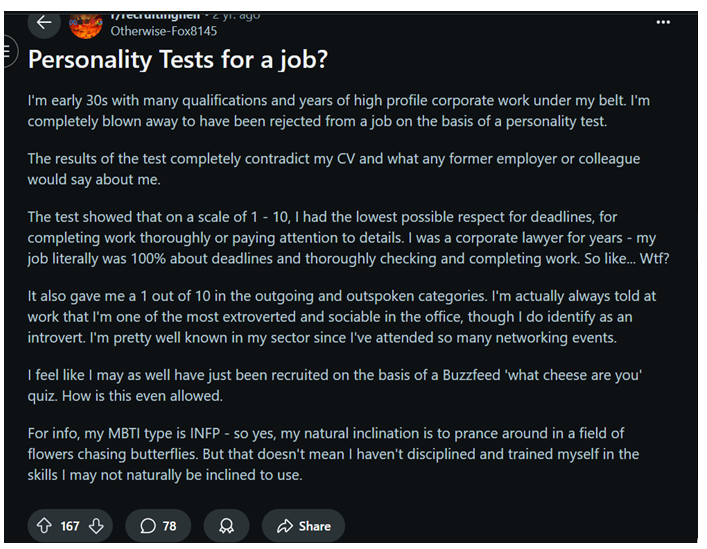
Source: https://www.reddit.com/r/recruitinghell/comments/14d9jjz/personality_tests_for_a_job/
As you can see, personality tests aren’t effective for hiring because they don’t predict how someone will actually perform in the role.
Think about it: someone might be an extrovert, but that doesn’t automatically make them a good salesperson. Sure, they might enjoy making friends, but when it comes to converting a stranger into a paying customer, they could struggle.
On the other hand, someone could be an introvert, but that doesn’t guarantee they’ll excel in a remote role. Just because they prefer quiet environments doesn’t mean they’ll take initiative or deliver on tasks in a remote work setting.
To be fair to every candidate, it’s better to give them a short skill test—a Minimum Viable Task—that lets them prove what they can actually do, rather than judging them based on personality traits.
What are the characteristics of a Minimum viable task?
- A Minimum Viable Task (MVT) must be specific.
When assigning a task to a candidate, you need to be crystal clear about what you want them to do. Let’s break this down with an example. Say you’re hiring a content writer for a legal blog. Here’s how you can assign a clear and effective MVT for that role:
Example Minimum Viable Task:
You’ve been assigned to write a blog article for a fictional legal website, “The Everyday Law Journal,” which helps small business owners understand complex legal topics in simple terms. Your task is to draft a 600–800 word blog post that explains “The Basics of Employment Contracts for Small Businesses.”
This is a strong MVT because it’s specific and clear:
- It outlines a purpose (writing for a legal blog).
- It specifies the type of task (drafting a blog post).
- It names the client (“The Everyday Law Journal”).
- It identifies the target audience (small business owners with no legal background).
- It defines the topic (“The Basics of Employment Contracts for Small Businesses”).
- It includes clear expectations/deliverables—the format (a word blog post) and the length (600–800 words).
This level of detail helps candidates understand exactly what’s required. That’s how a Minimum Viable Task should look: clear, specific, and focused on real-world work.
- A Minimum Viable Task must also be relevant.
This means the task should directly reflect the responsibilities of the role they are applying for.
Let’s go back to the earlier example. Imagine you’re hiring a content writer for a legal blog. The Minimum Viable Task we outlined (which is writing blog article for a legal website) is directly related to the job. It mirrors the type of work the candidate would actually do if hired.
That’s the key: your MVT must be directly relevant to the role you’re hiring for.
Unfortunately, some companies get this wrong when assigning skill tests. They assign irrelevant tasks that have nothing to do with the job. For example, here’s the experience of a confused candidate who applied for a job through a hiring platform called TestGorilla.
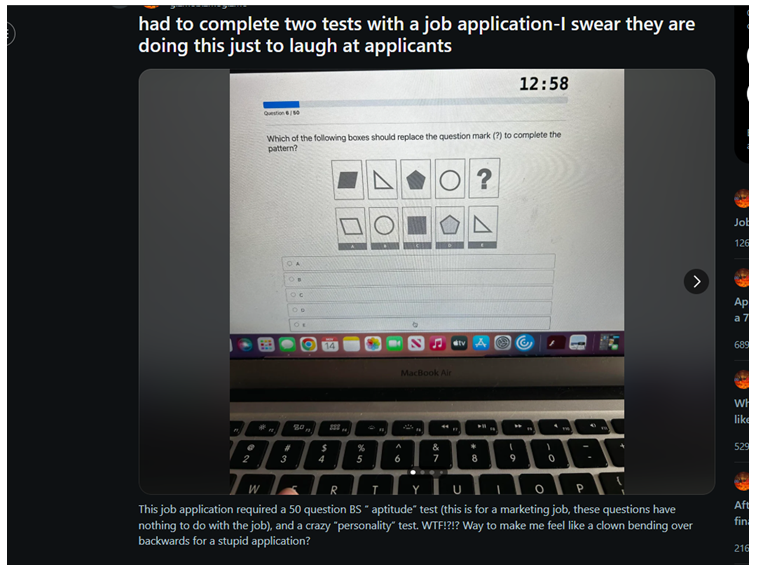
You should avoid this mistake—because irrelevant tasks frustrate candidates and harm your employer brand. To create a better candidate experience and protect your reputation, hire with WorkScreen.io. It’s the hiring platform that generates a relevant Minimum Viable Task for you with a single click without requiring your manual input. This way, you can easily test whether a candidate can actually do the job—without overwhelming them with tasks that have nothing to do with the role they’re applying for.
Quickly identify your most promising candidates using Workscreen. It automatically evaluates, scores, and ranks applicants on a performance-based leaderboard, making it easy to spot top talent, save time, and make smarter, data-driven hiring decisions.

➔A Minimum Viable Task Should Not be Overly Challenging or Overly Simple
An effective Minimum Viable Task (MVT) should be manageable—not too hard for a candidate to complete, but still challenging enough to test their ability to perform in the role. The goal is to create a task that pushes the candidate to think without overwhelming them.
For example, if you’re hiring someone to help with a Pinterest project, a poor MVT would be asking them to simply open a Canva account. That’s too basic—anyone can Google it and deliver. It doesn’t tell you anything about their skills.
A better MVT would be:
“Create one pin and explain how you did it.”
This task not only shows you who can actually design a pin, but their explanation also reveals much more about their technical abilities, creativity, and approach.
At the same time, a Minimum Viable Task shouldn’t be overly complex. For instance, it wouldn’t make sense to assign a task that realistically takes 8 hours but expect it to be completed in 2 hours. That’s unfair and places unnecessary pressure on candidates.
➔A Minimum Viable Task Should Be Time-Bound
A Minimum Viable Task (MVT) should include a reasonable deadline—typically 24 to 48 hours. This allows you to assess key factors like time management and accountability. For example, if you give a candidate 2 hours to complete a task and they submit it 8 hours later, it’s a clear sign they may struggle with managing their time at work. By setting clear deadlines, you create a fair, structured process that helps you identify who follows through—and who doesn’t.
➔A Minimum Viable Task Should Be Deliverable-Focused
It must have something concrete that the candidate is expected to submit after completing the task. A deliverable is the output the candidate provides and what you will use to evaluate them. Deliverables vary depending on the role. Here are a few examples to make this clearer:
- For a writing role: The deliverable could be “Submit an article in a Word document.”
- For a video editor: The deliverable could be “Submit a short video clip.”
- For a keyword researcher: The deliverable might be “Send an Excel spreadsheet with 10 target keywords.”
Deliverables generally fall into two categories:
- Text-based deliverables like an article, a report, or a PDF document.
- Non-text-based deliverables: Such as images, videos, pins, designs, and more.
For further clarification, take a look at the table below that illustrates these deliverable forms
Let’s assume you are hiring for either of these roles | Example of a short Skill test you can assign | Deliverable | Form of deliverable (Text or non-text based) |
Graphic Designer for a La Paz Fast Food restaurant | Design a promotional flyer for a new burger launch | Submit a JPG Image of the design | Non-text deliverable |
Sales Director for NovaTech Solutions, a mid-sized B2B SaaS company that offers cloud-based inventory management tools. The company is planning to expand into North America. | Develop a concise sales strategy that outlines how you will help increase sales in a new market region | Submit a PDF document outlining the strategy | Text deliverable |
Social media manager for an eco-friendly lifestyle brand | Draft one Instagram post for an upcoming product launch of reusable water bottles | Submit a Word document with the Instagram caption. Include a brief (2–3 sentences) explanation of your strategy | Text deliverable |
Note: For non-text deliverables, it’s always a good idea to ask the candidate to provide a brief explanation of their work. This helps you assess their thought process to understand how they approached the task.
Asking for an explanation also helps you gauge authenticity. A serious candidate who has genuinely completed the Minimum Viable Task should be able to clearly explain their reasoning without hesitation. For instance, if someone can’t explain how they created a design, it’s a red flag—they may not have done the work themselves.
Chapter 3
How Do You Incorporate the Minimum Viable Task Into Your Hiring Process?
The easiest and most efficient way to incorporate a Minimum Viable Task (MVT) into your hiring process is by using WorkScreen, a hiring platform that streamlines your hiring process. WorkScreen has the MVT built right into the system, so you can skip the hassle of creating custom tests from scratch—which can be time-consuming and complicated.
With just one click, you get a relevant, role-specific Minimum Viable Task tailored to your exact hiring needs. The process is simple:
- Simply create your job post on io, and the system will generate a unique link you can share across different sites to get candidates.
- WorkScreen then automatically evaluates every applicant, scores them, and ranks them on a clear leaderboard—so you can easily identify top talent, save time, and make confident hiring decisions.
- It also filters out low-effort applicants, including those using AI tools to apply, copy-pasting answers, or relying on “one-click apply” features. This means you focus only on genuine, committed, and high-quality candidates, helping you avoid costly hiring mistakes.
- Once you have identified the best candidates, you can conduct interviews and shortlist the best, then assign a skill test.
How to practically administer a minimum Viable Task using Workscreen
- Go to your dashboard and click on all job posts as shown below.

- Then select the job title you are hiring for from the list on your right.
In this case, let’s assume you are hiring a customer support representative.
- Click on that specific section as shown below.
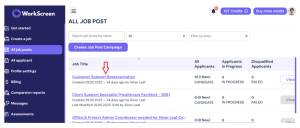
That action will direct you to the next page, which will look something like this
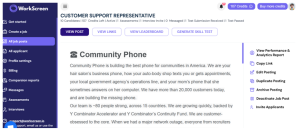
Before we show you the next step, here is an alternative method to get to this page.
- Start by going to your dashboard and clicking on all job posts.
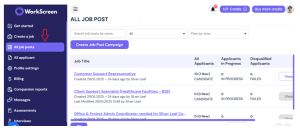
- Then choose the role you are hiring for.
Let’s assume you are still hiring a customer support representative. Instead of clicking on the specific role, navigate to your right using the blue line shown below:
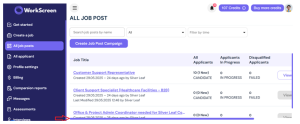
- Once you get to the end, you will see three dots across the role.
- Click on the three-dot icon as shown below.
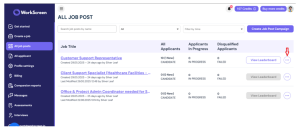
- A list will be displayed as shown below. From here, click on View Job Post as displayed.
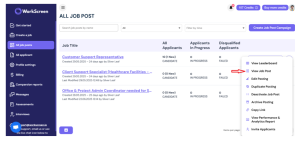
- Once you click on it, you will be directed to this page, where you can generate a skill test.
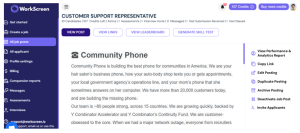
- Once you get here using either of the methods we have talked about, click on generate skill test
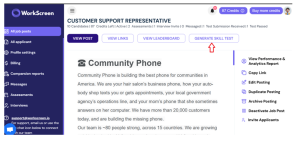
- Then scroll down the page using the navigation icon shown in the image below until you get to the part that’s labelled “Generate One-click skill test” and click on it
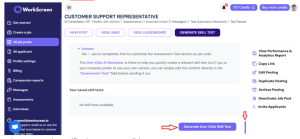
- When you get the notification message, click on yes.

- Once you do, wait for a few minutes for the system to automatically generate the skill test. Your screen will appear like this.
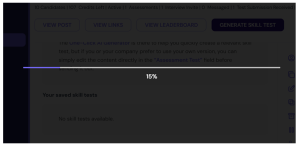
Once the system finishes generating the skill test, this page will be displayed.
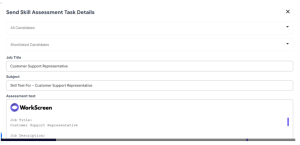
From here, you can now send the skill test to the candidates you want to send to.
- You can click on all candidates to see a list of the candidates that applied for your job, as shown below.
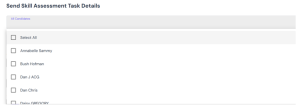
- If you want to send a skill test to all of them, click on select all, and you will see something like this.
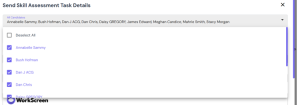
Selecting all saves you time because even if you are doing high-volume hiring, you don’t have to keep on selecting each candidate individually.
- But if you want to send the skill test to only your shortlisted candidates, click on Shortlisted candidates, and the list of shortlisted candidates will appear like this

- Once you have decided who to send the skill test to, scroll to the bottom of the page using the blue line shown below
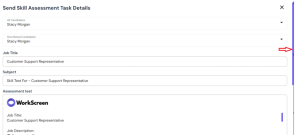
At the bottom of the page, you will see your job and then the skill test that the system has generated.
- Make sure you confirm that you have reviewed the skill test content by clicking on the button shown below.
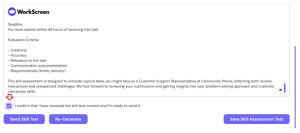
- Once you do this, you can now send the skill test by clicking on the send skill test button
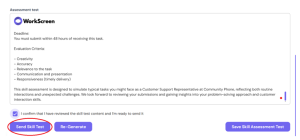
And if you would like to use the same skill test in the future when hiring for the same role, you can save it by clicking on the Save Skill Assessment Test, as shown below.
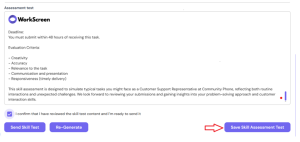
Once you click on save, a box will be displayed for you to title the skill test so that it is easy for you to find in the future. It looks like this
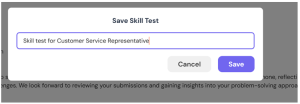
Name it and then click on save. Once you do, the system will successfully save the skill test and notify you like this.
![]()
The candidate is notified immediately you send them a skill test, and this is what they will see on their side.
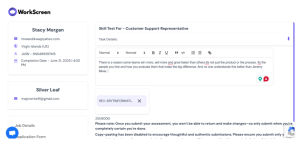
Once they submit the skill test, you have to scan for AI and plagiarism because in this age of AI, candidates are using AI tools like ChatGPT to polish their assessments or copy pasting content from different sources online.
- To scan for this, go to Assessments on your dashboard as shown below and click on it.
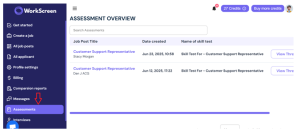
- Then click on the candidate you assigned the skill test to. In this case, we assigned it to Stacy Morgan.
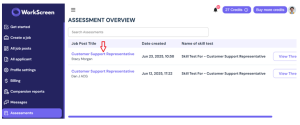
- Drag along the blue line shown below until you view the end of this page
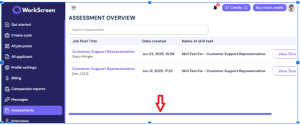
- Once you get to the end, you will see, view thread. Click on it.

The next page that will be displayed is the skill test page, where you will see the skill test you assigned and the candidate’s response.
- Once you go through the response, scroll up to the end of the page to scan for plagiarism and AI. Click on scan for plagiarism and AI as shown below.
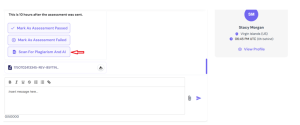
- Once you get this notification, click yes.
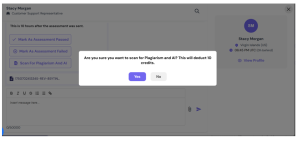
Wait for a few minutes for the scan to complete. Your screen will display this.
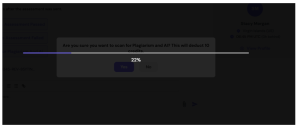
The results will be displayed as soon as the scan is complete as shown below.
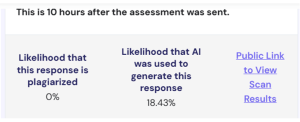
You can also click on the public link to view the scan results. Once you do this, you will be directed to Originality AI which helps scan for AI content manually.
But how do you skill test for non-remote roles?
For non-remote roles like a lawn mower for a landscaping company or a car wash attendant at a premium hand wash service, skill testing looks a bit different.
If you’re hiring online or remotely, it’s still helpful to start with a Minimum Viable Task (MVT) that can be completed before meeting in person. Ask candidates to describe, in detail, how they would perform the task—for example, how they would mow a lawn around trees and flower beds, or wash a large vehicle without leaving swirl marks. If someone has genuinely done this work before, they should be able to explain it clearly and practically.
That said, in an ideal scenario, an MVT for these hands-on roles would involve having the candidate perform the task physically—for example, mowing a small section of a lawn or washing part of a vehicle. A simple one-hour paid contract gives you a quick and fair way to assess their actual skills on the job.
Why Administer a Minimum Viable Task Through WorkScreen?
★ You save time
WorkScreen allows you to assign a Minimum Viable Task to all your shortlisted candidates at once—no need to send the task manually to each individual. This saves you time and reduces your workload.
- It’s Customizable
With WorkScreen, you can save your Minimum Viable Task as a draft, making it easy to reuse when hiring for the same role in the future. This way, you will not have to regenerate it again if you want to use the same one as before.
And if you want to make adjustments to your short skill test, you can easily customize it to fit your hiring needs. This flexibility gives WorkScreen a competitive edge in the hiring industry and makes your hiring process faster, more efficient, and tailored to your exact requirements.
★ You Can Message Candidates Within the System
Before assigning a Minimum Viable Task to top candidates, it’s important to inform them about it. If you skip this step and simply send out a task, some candidates may not respond at all. This is where WorkScreen makes a difference.
WorkScreen has a built-in messaging system that allows you to communicate with your shortlisted candidates without the need for separately emailing or calling them. All communications are conducted internally, keeping your process streamlined. By keeping candidates engaged and informed, they’re more likely to stay invested in your hiring process.
★ With WorkScreen, You Can Easily Verify Authenticity
WorkScreen has built-in AI and plagiarism detection, so you can trust that the work you receive from your candidates is authentic. This means you don’t have to spend extra time on third-party tools to verify a candidate’s task before hiring them. By integrating AI-powered checks directly into the platform, WorkScreen makes hiring more efficient and far less of a hassle. You get reliable, trustworthy results without the need for extra tools or manual verification.
Easily administer one-click skill tests using Workscreen and assess candidates based on real-world ability, not just credentials like résumés and past experience. Sign up now to hire more confidently and holistically.

Chapter 4
Useful Tips You Should Not Overlook
Scan for AI and plagiarism to ensure authenticity in this AI era
If you decide to assign a Minimum Viable Task without using WorkScreen, you need to be aware of the growing impact of AI in hiring and take steps to avoid ending up with low-effort applicants who will not deliver results. Unlike WorkScreen—which has built-in AI and plagiarism detection, assigning a Minimum Viable Task on your own means you’ll need to find additional tools to hire right. For instance, you will need:
- Copyscape Premium to flag plagiarized content and
- AI to check for AI-generated content
Without these tools, you risk unknowingly hiring candidates who submit work that is AI-generated, copied from somewhere else, or not truly their own.
And if your Minimum Viable Task involves a text-based deliverable/output, inform candidates upfront that their work will be scanned for plagiarism using Copyscape and for AI-generated content using Originality.AI. This transparency emphasizes the importance of honesty and discourages candidates from taking shortcuts.
For non-text deliverables, let candidates know they’ll be required to include a brief explanation of their process, such as the tools they used and the steps they took to complete the task. Make it clear that this explanation will also be checked for authenticity, ensuring the work truly reflects their own effort. Being upfront about these expectations helps you filter out unserious candidates before they waste your time.
Shortlist more candidates than you need
Avoid shortlisting exactly the number of people you plan to hire—this approach can easily backfire because not every candidate is reliable. Some may ghost you, others might start making excuses, and a few may not perform well on the task. To reduce the risk of these issues, it’s wise to shortlist more candidates than you actually need.
For example:
- If you’re looking to hire 5 top candidates, shortlist 8–10 people.
- If you need 10 top candidates, shortlist 13–15.
Does the MVT (Minimum Viable Task or short skill test) concept apply in the real world?
You might be wondering: “This all sounds great in theory—but do companies actually use Minimum Viable Tasks in real life?” The answer is yes—and they’ve been doing it for years. While they might not always call it an “MVT,” many businesses already apply this exact principle through short-term, low-risk tasks designed to assess a candidate’s real abilities before fully committing.
Here’s what this looks like in practice:
1. Employment Trial Periods
Some companies bring candidates on for a short-term contract—usually up to 90 days—before making a long-term commitment. This trial period acts as a real-world MVT, giving employers time to evaluate performance, culture fit, and reliability without the pressure of a permanent hire.
- Trial Shifts
In fast-paced industries where practical shifts are crucial, like hospitality, food or retail, trial shifts are common. Candidates are invited to work a few hours or a full day, allowing hiring managers to directly observe how they handle tasks, interact with clients, and adapt to the environment. It’s an MVT in action—just hands-on.
- Probationary Periods
Even after hiring, many companies use probationary periods (often 30 to 90 days) to monitor how a new hire performs on the job. Candidates are technically hired, but their long-term future with the company still hinges on proving they can do the work, meet the company’s standards and expectations.
- Pre-Work Trials Before Job Offers
Some employers, especially in the hospitality sector, assign pre-work trials before making a final hiring decision. These tasks allow both the candidate and the employer to assess fit, expectations, and skill alignment. It’s a way to test things out without a big commitment.
These real-world practices are proof that the Minimum Viable Task (MVT) isn’t just a theory—it’s already helping employers make smarter hiring decisions by testing real skills in practical, low-risk settings. At the same time, candidates get a fair chance to demonstrate their capabilities in a practical setting.
Final Thoughts
Hiring without testing for skills is like flying a plane blindfolded—sooner or later, you’re going to crash. Skill testing helps you distinguish between top talent and unserious candidates before hiring. But here’s the key: don’t overwhelm candidates with a full-day skill test. That’s counterproductive and leads to a bad candidate experience. The smarter way to assess a candidate’s ability is by giving them a short skill test—a Minimum Viable Task (MVT).
The Minimum Viable Task not only gives you a clear picture of a candidate’s capabilities but also helps you assess other critical traits. By incorporating an MVT into your hiring process, you reduce the risk of costly hiring mistakes, save time, and ensure you select the best talent for your team.
And WorkScreen.io makes it simple. You can administer a Minimum Viable Task with ease, save time and effort, customize tasks to your hiring needs, and verify authenticity—all in one platform. By using WorkScreen.io, you streamline your hiring process and create a better experience for candidates.
Hire with WorkScreen today—and easily assign a Minimum Viable Task to top candidates!


